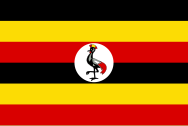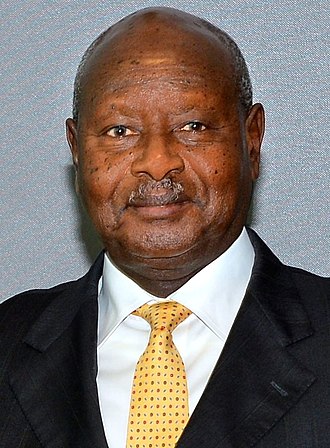Country Name: Uganda
Country Flag:

Indigenous Roots: Uganda has been inhabited for thousands of years by various ethnic groups, such as the Bantu, Nilotic, and Central Sudanic peoples. The kingdom of Buganda, established in the 14th century, became one of the most influential and powerful kingdoms in the region, while other kingdoms like Bunyoro, Ankole, and Toro also flourished.
Colonial Legacy: In 1894, Uganda became a British protectorate, with colonial rulers exploiting the country’s resources and imposing new political and economic systems. The British introduced cash crops like coffee and cotton, which led to the displacement of local agricultural practices. The colonial period also saw the introduction of Christianity and education, shaping Uganda’s political and social fabric. However, this era also sowed the seeds for ethnic tensions and divisions that would persist post-independence.
Monarchy to Republic: Uganda gained independence from Britain on October 9, 1962, becoming a constitutional monarchy under King Mutesa II of Buganda. The following years were marked by political instability, culminating in the 1971 military coup led by Idi Amin, who became the country’s dictator. Amin’s brutal regime, marked by widespread human rights abuses, economic decline, and ethnic purges, lasted until he was overthrown in 1979. Uganda then struggled with civil conflict until the National Resistance Movement (NRM) led by Yoweri Museveni took power in 1986.
Modern Transformation: Under Museveni’s leadership, Uganda experienced significant political stabilization and economic growth, with reforms aimed at improving infrastructure, health, and education. However, challenges such as corruption, human rights issues, and political repression have continued, particularly as Museveni has maintained power for decades, facing criticism for authoritarian tendencies. Despite these issues, Uganda remains one of East Africa’s more stable countries, with continued efforts toward economic development and regional cooperation.
Regional Influence: As of 2025, Uganda is a prominent member of the East African Community (EAC) and has shown growing involvement in regional peacekeeping and trade initiatives. The country has experienced steady economic growth, with its oil sector, agriculture, and services industries becoming key pillars of its economy. However, it still faces challenges such as poverty, infrastructure gaps, and political freedom. Uganda’s role in regional geopolitics, particularly in the Great Lakes region, remains significant, with involvement in peacekeeping efforts and conflict resolution initiatives.
Kampala
UTC+03:00 (East Africa Time – EAT) – Most of the country
Position in world: 91
Total Area: 241,038 square kilometers (93,065 sq mi)
Arable Land: 34.7%
Tropical Rainforest: Uganda has a tropical climate with two rainy seasons (March to May and September to November). The southwestern region, especially around Lake Victoria, has dense, evergreen forests and receives substantial rainfall year-round.
Savanna and Tropical Grasslands: The central and northern regions of Uganda experience a more pronounced dry season with savanna and grasslands. This area is home to extensive pastoral land and agricultural activities.
Highland and Temperate Zones: Uganda’s mountainous regions, especially in the west near the Rwenzori Mountains, have a cooler, temperate climate, with temperatures dropping as low as 10°C (50°F) at higher altitudes.
Uganda is divided into four administrative regions:
Natural Disaster Susceptibility Flooding: Uganda is vulnerable to flooding, especially during heavy rains in the rainy season, particularly in urban areas and low-lying agricultural zones.
Drought: The northeastern parts of Uganda often face periodic droughts, which affect water supplies and agriculture, leading to food insecurity.
Landslides: The mountainous regions, particularly in the southwest near the Rwenzori Mountains, are prone to landslides during heavy rainfall, impacting rural communities.
Disease Outbreaks: Uganda also faces health-related natural disasters such as malaria, cholera, and Ebola, which are often exacerbated by seasonal changes.
Uganda is a landlocked country with no direct access to the sea but has a significant coastline on Lake Victoria, which is shared with Kenya and Tanzania. It maintains territorial waters on the lake and holds fishing and transport rights within the waters, essential for regional trade and livelihoods.
Power Structure: Uganda operates as a presidential republic, with the president serving as both head of state and head of government. The president holds extensive executive powers, including appointing ministers and directing government policy. Presidential elections are held every five years, and there is no limit on the number of terms a president can serve. The current president is Yoweri Museveni, in power since 1986.
Parliamentary Framework: Uganda’s legislative authority is vested in the unicameral Parliament, composed of directly elected members and representatives from special interest groups, including women, youth, workers, and persons with disabilities. The Parliament enacts laws, debates policies, and approves the national budget.
Political Parties and Pluralism: Uganda has a multi-party system, but the political landscape is dominated by the National Resistance Movement (NRM), led by President Museveni. While opposition parties, such as the Forum for Democratic Change (FDC) and the National Unity Platform (NUP), exist, they face significant challenges, including restricted political space and allegations of state repression.
Governance and Decentralization: Uganda follows a decentralized system of governance, empowering local government councils to oversee regional administration and service delivery. However, central government influence remains significant, particularly through presidential appointees in key positions.
Uganda plays a crucial role in the East African Community (EAC), promoting economic integration and cooperation with neighboring countries. The EAC is composed of Uganda, Kenya, Tanzania, Rwanda, Burundi, South Sudan, and the Democratic Republic of Congo (DRC), fostering free movement of goods and people.
Uganda maintains a strong military presence in the region, actively participating in peacekeeping missions, most notably under the African Union Mission in Somalia (AMISOM). Its military strength has positioned Uganda as a key player in regional security dynamics.
Key Allies:
Diplomatic Challenges: Uganda’s involvement in regional conflicts, especially in the DRC and South Sudan, has drawn both criticism and strategic interest from international partners. Human rights concerns and governance challenges occasionally strain relations with Western countries.
Government Type: Presidential republic
President:
Yoweri Museveni
(in power since 1986)

Regional Diplomacy: Uganda emphasizes strong ties with East African Community (EAC) member states and supports regional economic integration.
Peacekeeping Commitments: Actively participates in regional security, notably through peacekeeping missions such as AMISOM in Somalia.
Development Cooperation: Engages in bilateral and multilateral development partnerships, focusing on infrastructure and economic collaboration, particularly with China and the European Union.
Strategic Partnerships: Strengthens ties with global powers like the United States and China while maintaining a pragmatic foreign policy approach.
Size in World: 91st
GDP: $55.59 billion
GDP per capita: $2,339
Currency: Ugandan shilling (UGX)
Dominant Economic Sector: Agriculture
Market Type: Mixed Economy
Social Landscape
Population: 46.1 million (2024)
Position: Class Distribution:
Upper: 1%
Middle: 25%
Lower: 74%
Gini Coefficient: 43 (indicating high income inequality, where 0 = perfect equality and 100 = perfect inequality)
Language
Official Language: English
Other Languages: Luganda, Swahili, Runyankore, Lusoga, among others
Religion
Dominant Religion: Christianity (predominantly Roman Catholicism and Anglicanism)
Other Religions: Islam, Pentecostal Christianity, Hinduism, Indigenous beliefs